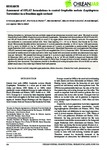Use este identificador para citar ou linkar para este item:
http://www.alice.cnptia.embrapa.br/alice/handle/doc/995793Registro completo de metadados
| Campo DC | Valor | Idioma |
|---|---|---|
| dc.contributor.author | ARIOLI, C. J. | pt_BR |
| dc.contributor.author | PASTORI, P. L. | pt_BR |
| dc.contributor.author | BOTTON, M. | pt_BR |
| dc.contributor.author | GARCIA, M. S. | pt_BR |
| dc.contributor.author | BORGES, R. | pt_BR |
| dc.contributor.author | MAFRA-NETO, A. | pt_BR |
| dc.date.accessioned | 2014-09-24T11:11:11Z | pt_BR |
| dc.date.available | 2014-09-24T11:11:11Z | pt_BR |
| dc.date.created | 2014-09-24 | pt_BR |
| dc.date.issued | 2014 | pt_BR |
| dc.identifier.citation | Chilean Journal of Agricultural Research, v. 74, n. 2, p. 184-190, Apr./Jun. 2014. | pt_BR |
| dc.identifier.uri | http://www.alice.cnptia.embrapa.br/alice/handle/doc/995793 | pt_BR |
| dc.description | Mating disruption is a technique that uses synthetic copies of sex pheromones to control insect pests. We aimed to control Oriental fruit moth (OFM) Grapholita molesta (Busck) (Lepidoptera: Tortricidae) with formulations of SPLAT Grafo (SG) and SPLAT Grafo Attract and Kill (SGAK) in small (1 ha) apple (Malus domestica Borkh.) orchards. Our experiment was conducted in a commercial orchard with Gala trees (spacing 1.5 × 4.5 m) in Vacaria, Rio Grande do Sul State, Brazil. We evaluated the effect of four treatments on G. molesta population densities: a) SG at 1 kg ha-1 (300 point sources of 3.3 g each), b) SGAK at 1 kg ha-1 (1000 point sources of 1 g each), c) insecticides as recommended by Integrated Apple Production (IAP), and d) untreated control (no treatment). Specialized Pheromone and Lure Application Technology (SPLAT) treatments were applied on 1 August 2004 and reapplied after 120 d (1 December 2004). The treatment effect was evaluated by weekly counts of males captured in Delta traps baited with commercial synthetic sex pheromone lures (eight traps per treatment). We assessed fruit damage caused by G. molesta in eight replicates of 200 fruits each on 26 October, 30 November 2004, and 5 and 31 January 2005. Applying 1 kg ha-1 of SG and SGAK in August and December 2004 significantly reduced the number of male moths caught in Delta traps. Damage to fruits at harvest, however, did not differ significantly from the control. This indicates a decline in the efficacy of mating disruption when SG and SGAK are used to protect small areas (1 ha) under high Oriental fruit moth pressure. | pt_BR |
| dc.language.iso | por | pt_BR |
| dc.rights | openAccess | pt_BR |
| dc.subject | Oriental fruit moth | pt_BR |
| dc.subject | Gala | pt_BR |
| dc.title | Assessment of SPLAT formulations to control Grapholita molesta (Lepidoptera:Tortricidae) in a Brazilian apple orchard. | pt_BR |
| dc.type | Artigo de periódico | pt_BR |
| dc.date.updated | 2019-04-02T11:11:11Z | pt_BR |
| dc.subject.thesagro | Maçã | pt_BR |
| dc.subject.thesagro | Controle integrado | pt_BR |
| dc.subject.thesagro | Praga de planta | pt_BR |
| dc.subject.thesagro | Inseticida | pt_BR |
| dc.subject.thesagro | Grapholita Molesta | pt_BR |
| riaa.ainfo.id | 995793 | pt_BR |
| riaa.ainfo.lastupdate | 2019-04-02 -03:00:00 | pt_BR |
| dc.contributor.institution | Cristiano João Arioli; Patrik Luiz Pastori; MARCOS BOTTON, CNPUV; Mauro Silveira Garcia; Rafael Borges; Agenor Mafra-Neto. | pt_BR |
| Aparece nas coleções: | Artigo em periódico indexado (CNPUV)  | |
Arquivos associados a este item:
| Arquivo | Descrição | Tamanho | Formato | |
|---|---|---|---|---|
| JARGrapholitamolesta.pdf | 553,63 kB | Adobe PDF |  Visualizar/Abrir |









